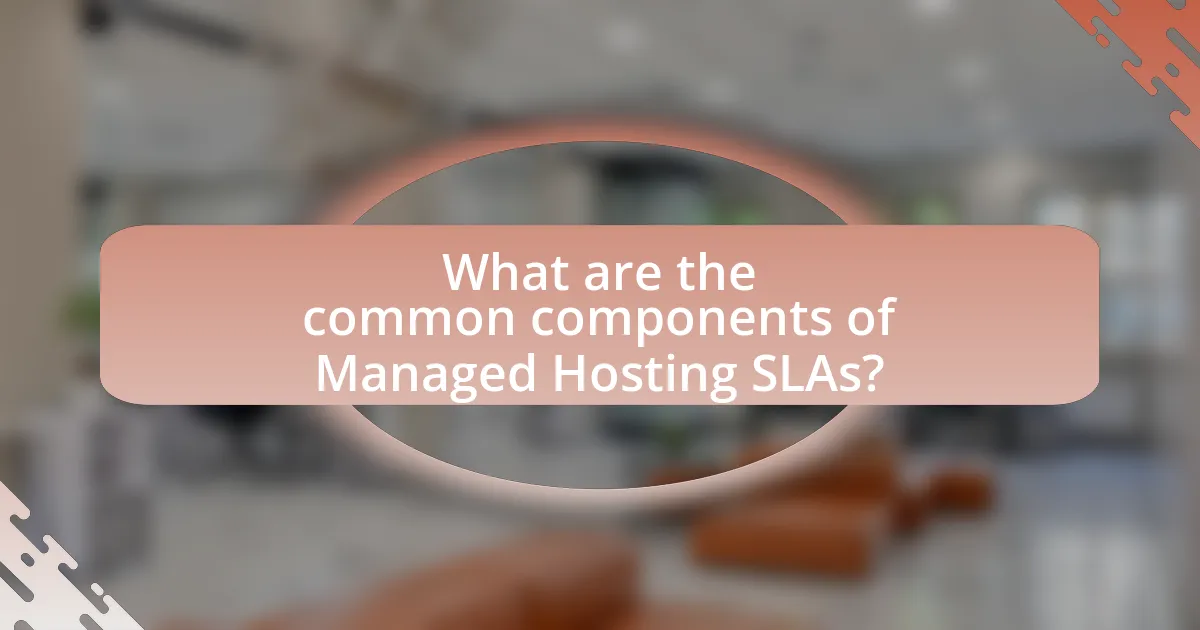Managed Hosting Service Level Agreements (SLAs) are formal contracts that define the expected service levels between a managed hosting provider and a client, including uptime guarantees, support response times, and performance metrics. This article outlines the key components of Managed Hosting SLAs, such as uptime guarantees, response times, data backup procedures, and security measures, while also highlighting the differences between managed and traditional hosting agreements. Additionally, it discusses the importance of SLAs for ensuring accountability and reliability, offers guidance on evaluating and negotiating SLAs, and identifies common pitfalls to avoid. Understanding these elements is crucial for businesses seeking to establish effective and transparent relationships with their hosting providers.

What are Managed Hosting SLAs?
Managed Hosting SLAs, or Service Level Agreements, are formal contracts between a managed hosting provider and a client that outline the expected level of service, including uptime guarantees, support response times, and performance metrics. These agreements typically specify the provider’s obligations regarding system availability, maintenance schedules, and remedies for service failures, ensuring accountability and clarity in the service relationship. For instance, a common SLA might guarantee 99.9% uptime, meaning the service is expected to be operational and accessible 99.9% of the time within a given period, which is a standard benchmark in the industry.
How do Managed Hosting SLAs differ from traditional hosting agreements?
Managed Hosting SLAs differ from traditional hosting agreements primarily in their level of service commitment and support. Managed Hosting SLAs typically guarantee specific performance metrics, such as uptime percentages (often 99.9% or higher), response times for support requests, and proactive monitoring, which are not always explicitly defined in traditional hosting agreements. For instance, a managed hosting provider may offer 24/7 support with guaranteed response times of under one hour, while traditional hosting may only provide limited support during business hours without such guarantees. This distinction highlights the enhanced reliability and accountability that Managed Hosting SLAs provide, ensuring that businesses receive consistent and high-quality service.
What key elements are typically included in a Managed Hosting SLA?
A Managed Hosting Service Level Agreement (SLA) typically includes key elements such as uptime guarantees, response times for support, data backup and recovery procedures, security measures, and penalties for non-compliance. Uptime guarantees often specify a percentage of availability, commonly 99.9%, ensuring that services remain operational. Response times outline how quickly the provider will address issues, often categorized by severity levels. Data backup and recovery procedures detail how often backups occur and the restoration process, ensuring data integrity. Security measures include protocols for protecting data and infrastructure from breaches. Finally, penalties for non-compliance may involve service credits or financial compensation if the provider fails to meet the agreed-upon standards.
Why are SLAs important for managed hosting services?
SLAs, or Service Level Agreements, are crucial for managed hosting services because they define the expected level of service, performance metrics, and responsibilities of both the service provider and the client. These agreements ensure accountability by specifying uptime guarantees, response times for support, and remedies for service failures, which are essential for maintaining business continuity. For instance, a typical SLA may guarantee 99.9% uptime, meaning that the service provider commits to minimal downtime, thereby providing clients with confidence in the reliability of their hosting services. This structured approach helps businesses mitigate risks associated with service interruptions and aligns expectations, ultimately fostering a transparent and trustworthy relationship between the provider and the client.
What should you consider when evaluating Managed Hosting SLAs?
When evaluating Managed Hosting SLAs, you should consider the service level guarantees, including uptime commitments, response times, and support availability. These guarantees are critical as they define the reliability and performance you can expect from the hosting provider. For instance, a common SLA might promise 99.9% uptime, which translates to approximately 8.76 hours of downtime annually. Additionally, assess the penalties for non-compliance, as they provide insight into the provider’s accountability. Understanding the scope of support, including the hours of operation and the channels available (such as phone, email, or chat), is also essential, as it affects your ability to resolve issues promptly. Finally, review the terms regarding data security and backup procedures, as these elements are vital for protecting your information and ensuring business continuity.
How do uptime guarantees impact your choice of a managed hosting provider?
Uptime guarantees significantly influence the selection of a managed hosting provider by assuring reliability and performance. A provider that offers a high uptime guarantee, typically 99.9% or higher, indicates a commitment to maintaining server availability, which is crucial for businesses that rely on their online presence. For instance, a study by Gartner shows that even a minute of downtime can cost businesses thousands of dollars, emphasizing the importance of uptime in operational continuity. Therefore, when evaluating managed hosting options, prioritizing providers with robust uptime guarantees can lead to better service reliability and reduced risk of revenue loss due to outages.
What response times should you expect in a Managed Hosting SLA?
In a Managed Hosting SLA, you should expect response times typically ranging from 15 minutes to 1 hour for critical issues, and up to 24 hours for non-critical issues. These response times are established to ensure timely support and resolution of problems, which is crucial for maintaining service availability and performance. For instance, many providers specify that a response time of 15 minutes applies to high-severity incidents that significantly impact operations, while lower-severity issues may have a longer response window. This structure is designed to prioritize urgent matters effectively, ensuring that businesses can rely on their hosting services for operational continuity.

What are the common components of Managed Hosting SLAs?
Common components of Managed Hosting SLAs include uptime guarantees, support response times, data backup and recovery procedures, security measures, and performance metrics. Uptime guarantees typically specify a percentage of time the service will be operational, often aiming for 99.9% or higher. Support response times outline how quickly the provider will respond to issues, often categorized by severity levels. Data backup and recovery procedures detail how often backups occur and the process for restoring data. Security measures include protocols for protecting data and infrastructure, such as firewalls and encryption. Performance metrics may involve monitoring server speed and resource allocation to ensure optimal service delivery. These components are essential for establishing clear expectations and accountability between the service provider and the client.
What types of service level metrics are included in SLAs?
Service Level Agreements (SLAs) typically include several key service level metrics such as uptime, response time, resolution time, and performance benchmarks. Uptime metrics define the percentage of time services are operational, often targeted at 99.9% or higher. Response time metrics measure how quickly a service provider acknowledges a request, while resolution time metrics indicate the duration taken to resolve issues. Performance benchmarks assess the speed and efficiency of services, ensuring they meet predefined standards. These metrics are critical for evaluating the reliability and quality of managed hosting services.
How is uptime measured and reported in Managed Hosting SLAs?
Uptime in Managed Hosting SLAs is measured as the percentage of time that a service is operational and accessible over a defined period, typically calculated monthly or annually. This measurement is reported using metrics such as “99.9% uptime,” which indicates that the service is expected to be down for no more than approximately 40 minutes per month. Providers often utilize monitoring tools to track uptime and generate reports that detail service availability, including any downtime incidents and their durations, ensuring transparency and accountability in service delivery.
What are the implications of service credits in SLAs?
Service credits in Service Level Agreements (SLAs) serve as a financial remedy for clients when service providers fail to meet agreed-upon performance metrics. These credits typically reduce future service fees or provide monetary compensation, incentivizing providers to maintain high service standards. For instance, if a provider guarantees 99.9% uptime and fails to meet this threshold, clients may receive service credits proportional to the downtime experienced, reinforcing accountability. This mechanism not only protects clients but also encourages providers to enhance service reliability, ultimately fostering a more trustworthy business relationship.
How do support and maintenance clauses affect Managed Hosting SLAs?
Support and maintenance clauses significantly influence Managed Hosting Service Level Agreements (SLAs) by defining the scope and quality of technical assistance and system upkeep provided to clients. These clauses typically outline response times for support requests, the availability of support personnel, and the frequency of maintenance activities, which directly impact service reliability and performance. For instance, an SLA that guarantees 24/7 support with a maximum response time of one hour ensures that clients receive timely assistance during critical issues, thereby minimizing downtime. Additionally, regular maintenance schedules specified in the SLA can prevent potential disruptions by ensuring that systems are updated and optimized. Therefore, the presence and specificity of support and maintenance clauses are crucial for establishing clear expectations and accountability between service providers and clients in Managed Hosting agreements.
What level of support should be guaranteed in a Managed Hosting SLA?
A Managed Hosting Service Level Agreement (SLA) should guarantee 24/7 technical support, including response times for critical issues typically within one hour. This level of support ensures that clients receive immediate assistance during outages or significant performance issues, which is crucial for maintaining uptime and service reliability. According to industry standards, a well-defined SLA should also specify the availability of support channels, such as phone, email, and live chat, to facilitate prompt communication.
How often should maintenance windows be scheduled according to SLAs?
Maintenance windows should be scheduled according to SLAs at least once a month. This frequency is often stipulated in SLAs to ensure regular updates, security patches, and system optimizations, which are essential for maintaining service reliability and performance. Many SLAs also specify that maintenance should occur during off-peak hours to minimize impact on users, reinforcing the importance of adhering to a structured maintenance schedule.

What are the best practices for negotiating Managed Hosting SLAs?
The best practices for negotiating Managed Hosting SLAs include clearly defining service expectations, establishing measurable performance metrics, and ensuring flexibility for future needs. Clearly defining service expectations allows both parties to understand their responsibilities, while measurable performance metrics, such as uptime guarantees and response times, provide a basis for accountability. Flexibility is crucial as business needs may evolve, necessitating adjustments to the SLA. According to a study by Gartner, organizations that establish clear SLAs experience 30% fewer service disruptions, highlighting the importance of these practices in effective SLA negotiations.
How can you ensure that your specific needs are met in an SLA?
To ensure that your specific needs are met in a Service Level Agreement (SLA), clearly define your requirements and expectations before negotiating the SLA. This involves identifying critical performance metrics such as uptime, response times, and support availability that align with your business objectives. For instance, if your business requires 99.9% uptime, explicitly state this in the SLA to hold the service provider accountable. Additionally, review existing SLAs from similar services to benchmark your needs against industry standards, ensuring that your requirements are realistic and achievable. By documenting these needs and discussing them with the service provider, you create a mutual understanding that enhances compliance and satisfaction with the SLA.
What questions should you ask potential providers about their SLAs?
When evaluating potential providers about their Service Level Agreements (SLAs), you should ask specific questions to ensure clarity and alignment with your needs. Key questions include:
- What are the guaranteed uptime percentages, and how are they calculated?
- What compensation is offered for service outages or failures to meet SLA commitments?
- What response times can be expected for support requests, and how are they categorized?
- Are there any exclusions or limitations in the SLA that could affect service delivery?
- How often are SLAs reviewed and updated, and what is the process for notifying clients of changes?
These questions help clarify the provider’s commitments and ensure that their SLAs align with your operational requirements.
How can you assess the flexibility of an SLA during negotiations?
To assess the flexibility of a Service Level Agreement (SLA) during negotiations, examine the terms related to service modifications, performance metrics, and penalties for non-compliance. Flexibility can be indicated by clauses that allow for adjustments in service levels based on changing business needs or unforeseen circumstances. For instance, if the SLA includes provisions for renegotiation or amendment based on performance reviews or customer feedback, it demonstrates a willingness to adapt. Additionally, the presence of clear metrics for service delivery and the ability to modify these metrics as business requirements evolve further indicates flexibility. An SLA that outlines specific processes for addressing service failures and allows for remediation options also reflects a more adaptable agreement.
What common pitfalls should you avoid when reviewing Managed Hosting SLAs?
When reviewing Managed Hosting SLAs, avoid overlooking critical service level metrics such as uptime guarantees, response times, and support availability. These metrics are essential as they directly impact the reliability and performance of the hosting service. Additionally, neglecting to scrutinize the terms regarding data security and compliance can lead to vulnerabilities, as many SLAs may not clearly define the provider’s responsibilities in these areas. Furthermore, failing to understand the penalties for non-compliance or service failures can result in unexpected costs or inadequate recourse. Lastly, not considering the scalability options outlined in the SLA can hinder future growth, as many providers may impose limitations that affect your ability to expand services seamlessly.
What vague terms should you watch out for in SLAs?
Vague terms to watch out for in Service Level Agreements (SLAs) include “reasonable,” “best efforts,” “as soon as possible,” and “high availability.” These terms lack specific definitions and can lead to ambiguity regarding the service provider’s obligations. For instance, “reasonable” does not quantify the level of service expected, while “best efforts” may not guarantee a specific outcome. The term “as soon as possible” can vary widely in interpretation, leading to potential delays. Additionally, “high availability” often lacks a clear percentage or uptime guarantee, making it difficult to assess reliability. These vague terms can create misunderstandings and disputes between service providers and clients, emphasizing the need for precise language in SLAs.
How can hidden fees impact the overall value of a Managed Hosting SLA?
Hidden fees can significantly reduce the overall value of a Managed Hosting Service Level Agreement (SLA) by increasing the total cost of ownership beyond initial estimates. When clients encounter unexpected charges for services such as data backups, additional bandwidth, or technical support, the perceived value of the SLA diminishes as the actual expenses exceed the budgeted amounts. According to a study by the International Data Corporation, 30% of businesses reported that hidden fees in service agreements led to budget overruns, highlighting the importance of transparency in pricing. This lack of clarity can result in dissatisfaction and a feeling of being misled, ultimately affecting the client’s trust and long-term relationship with the service provider.
What are the key takeaways for understanding Managed Hosting SLAs?
Key takeaways for understanding Managed Hosting SLAs include the definition of service level agreements, which outline the expected service performance and responsibilities of the hosting provider. Key components to focus on are uptime guarantees, typically expressed as a percentage, which indicate the reliability of the service; response times for support, detailing how quickly issues will be addressed; and penalties for non-compliance, which provide recourse if the provider fails to meet agreed standards. Additionally, understanding the scope of services covered, including backups, security measures, and maintenance schedules, is crucial for evaluating the overall value and reliability of the managed hosting service.
How can you effectively compare SLAs from different providers?
To effectively compare SLAs from different providers, analyze key components such as uptime guarantees, response times, support availability, and penalties for non-compliance. Uptime guarantees typically range from 99.9% to 99.999%, with higher percentages indicating more reliable service. Response times should be clearly defined, specifying how quickly the provider will address issues, often measured in minutes or hours. Support availability is crucial; check if support is 24/7 or limited to business hours. Additionally, review the penalties outlined for failing to meet SLA commitments, as these can indicate the provider’s confidence in their service. By systematically evaluating these factors, you can make an informed decision based on concrete performance metrics and service reliability.
What resources are available for further learning about Managed Hosting SLAs?
Resources for further learning about Managed Hosting SLAs include industry publications, online courses, and vendor documentation. Industry publications such as “The SLA Handbook” by David A. H. Smith provide comprehensive insights into service level agreements. Online platforms like Coursera and Udemy offer courses specifically focused on IT service management and SLAs. Additionally, major managed hosting providers often publish whitepapers and detailed SLA documents on their websites, which serve as practical examples and guidelines. These resources collectively enhance understanding of Managed Hosting SLAs and their implications in service delivery.


